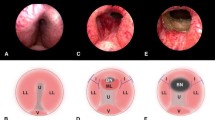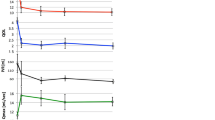Abstract
Introduction
To evaluate the impact of a modified transurethral resection of prostate (mTURP) in patients with a history of pelvic fracture urethral injury (PFUI) status post-urethroplasty, and subsequent lower urinary tract symptoms (LUTS) refractory to medical therapy caused by benign prostatic hyperplasia (BPH).
Methods
Five patients were identified with a history of PFUI and a successful reconstruction of the urethra, who developed severe LUTS. After maximal medical therapy failed, these patients underwent a mTURP. Their continence status and voiding parameters were recorded before and after surgery.
Results
Significant improvements in both post-void residual (172 ± 137.36 mL vs. 26.6 ± 24.44 mL), p = 0.026, and International Prostatic Symptom Score (23.6 ± 4.82 vs. 7.6 ± 4.30), p = 0.002 were observed in the study. Although maximum flow rate was not statistically significant, there was an overall improvement in Qmax in all patients (8.92 ± 3.71 vs. 16.78 ± 6.44 mL/sec). Furthermore, all patients remained continent after this modified intervention.
Conclusion
Our modified TURP provides an adjunctive option in the management of severe LUTS secondary to BPH in patients with a history of PFUI urethroplasty who are refractory to medical management. In our experience, the patients experienced a lasting response with no incontinence.


Similar content being viewed by others
Abbreviations
- PFUI:
-
Pelvic fracture urethral injury
- BPH:
-
Benign prostatic hyperplasia
- mTURP:
-
Modified transurethral resection of prostate
- LUTS:
-
Lower urinary tract symptoms
- PVR:
-
Post-void residual
- IPSS:
-
International Prostate Symptom Score
- TRUS:
-
Transrectal ultrasound
- IPP:
-
Intravesical prostatic protrusion
- TURP:
-
Transurethral resection of prostate
References
Bagga HS, Angermeier KW (2015) The mechanism of continence after posterior urethroplasty. Arab J Urol 13(1):60–63
Al-Rifaei MA, Al-Rifaei AM, Al-Angabawy A (2004) Management of urinary incontinence after bulboprostatic anastomotic urethroplasty for posterior urethral obstruction secondary to pelvic fracture. Scand J Urol Nephrol 38(1):42–46
Koraitim MM et al (2003) Mechanism of continence after repair of post-traumatic posterior urethral strictures. Urology 61(2):287–290
Whitson JM et al (2008) Mechanism of continence after repair of posterior urethral disruption: evidence of rhabdosphincter activity. J Urol 179(3):1035–1039
Koraitim MM (1999) Pelvic fracture urethral injuries: the unresolved controversy. J Urol 161(5):1433–1441
Gomez RG, Scarberry K (2018) Anatomy and techniques in posterior urethroplasty. Transl Androl Urol 7(4):567–579
Keqin Z et al (2007) Clinical significance of intravesical prostatic protrusion in patients with benign prostatic enlargement. Urology 70(6):1096–1099
Lee LS et al (2010) Intravesical prostatic protrusion predicts clinical progression of benign prostatic enlargement in patients receiving medical treatment. Int J Urol 17(1):69–74
Shin SH et al (2013) Defining the degree of intravesical prostatic protrusion in association with bladder outlet obstruction. Korean J Urol 54(6):369–372
Palmer JK, Benson GS, Corriere JN Jr (1983) Diagnosis and initial management of urological injuries associated with 200 consecutive pelvic fractures. J Urol 130(4):712–714
Iselin CE, Webster GD (1999) The significance of the open bladder neck associated with pelvic fracture urethral distraction defects. J Urol 162(2):347–351
Funding
None
Author information
Authors and Affiliations
Contributions
Mishra: data analysis, manuscript writing/editing, Cristina Baeza: data analysis, protocol/project management, Laura Bukavina: data analysis, manuscript writing/editing, Reynaldo G. Gómez: protocol/project management, data analysis, manuscript writing/editing.
Corresponding author
Ethics declarations
Conflict of interest
All authors declare that they have no conflict of interest.
Ethical approval
All procedures performed in studies involving human participants were in accordance with the ethical standards of the institutional and/or national research committee and with the 1964 Helsinki Declaration and its later amendments or comparable ethical standards.
Additional information
Publisher's Note
Springer Nature remains neutral with regard to jurisdictional claims in published maps and institutional affiliations.
Rights and permissions
About this article
Cite this article
Mishra, K., Baeza, C., Bukavina, L. et al. Modified transurethral resection of the prostate for the management of BPH-related refractory lower urinary tract symptoms in patients with a history of pelvic fracture urethral injury reconstruction. Int Urol Nephrol 51, 2137–2141 (2019). https://doi.org/10.1007/s11255-019-02276-1
Received:
Accepted:
Published:
Issue Date:
DOI: https://doi.org/10.1007/s11255-019-02276-1




